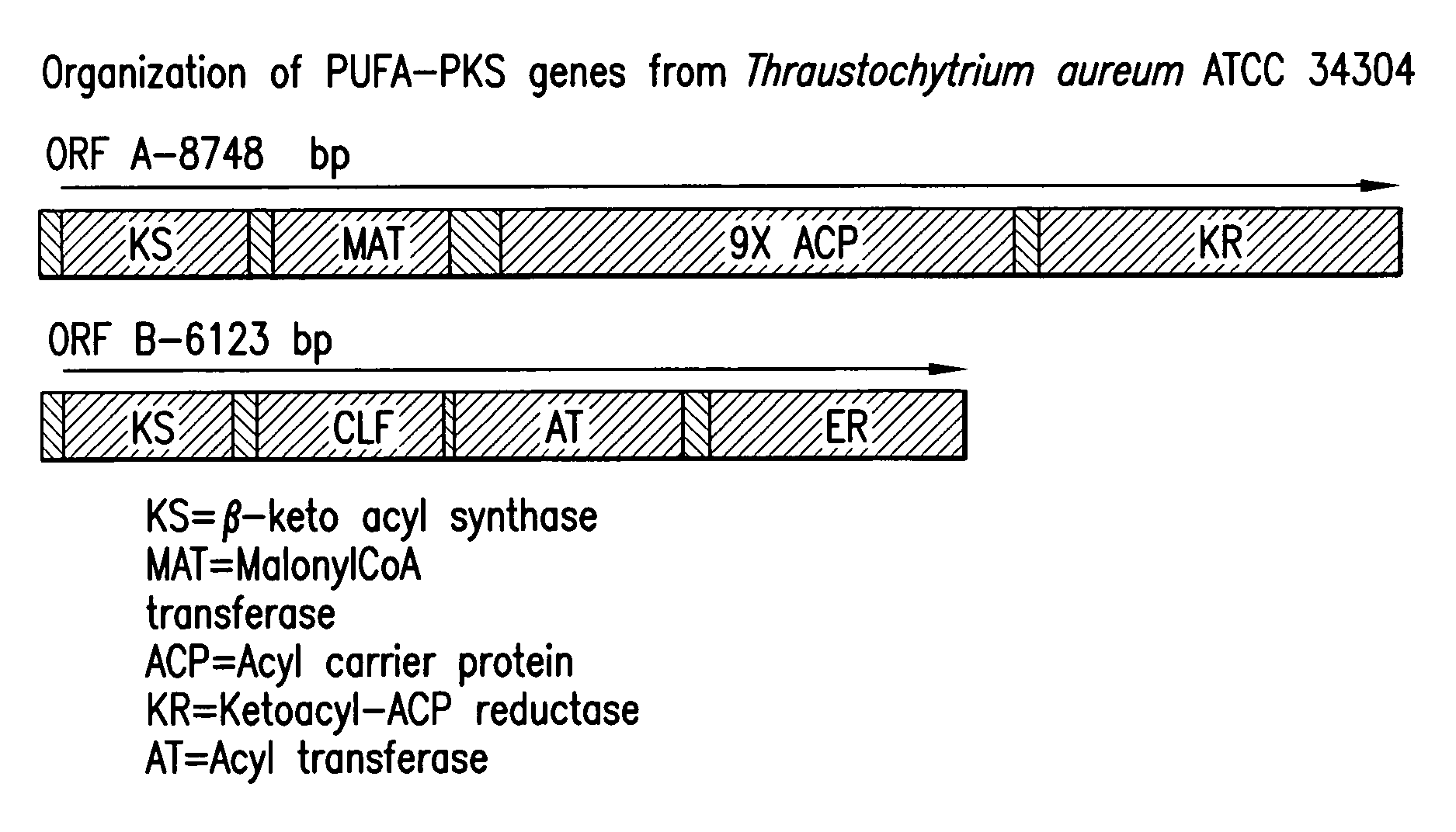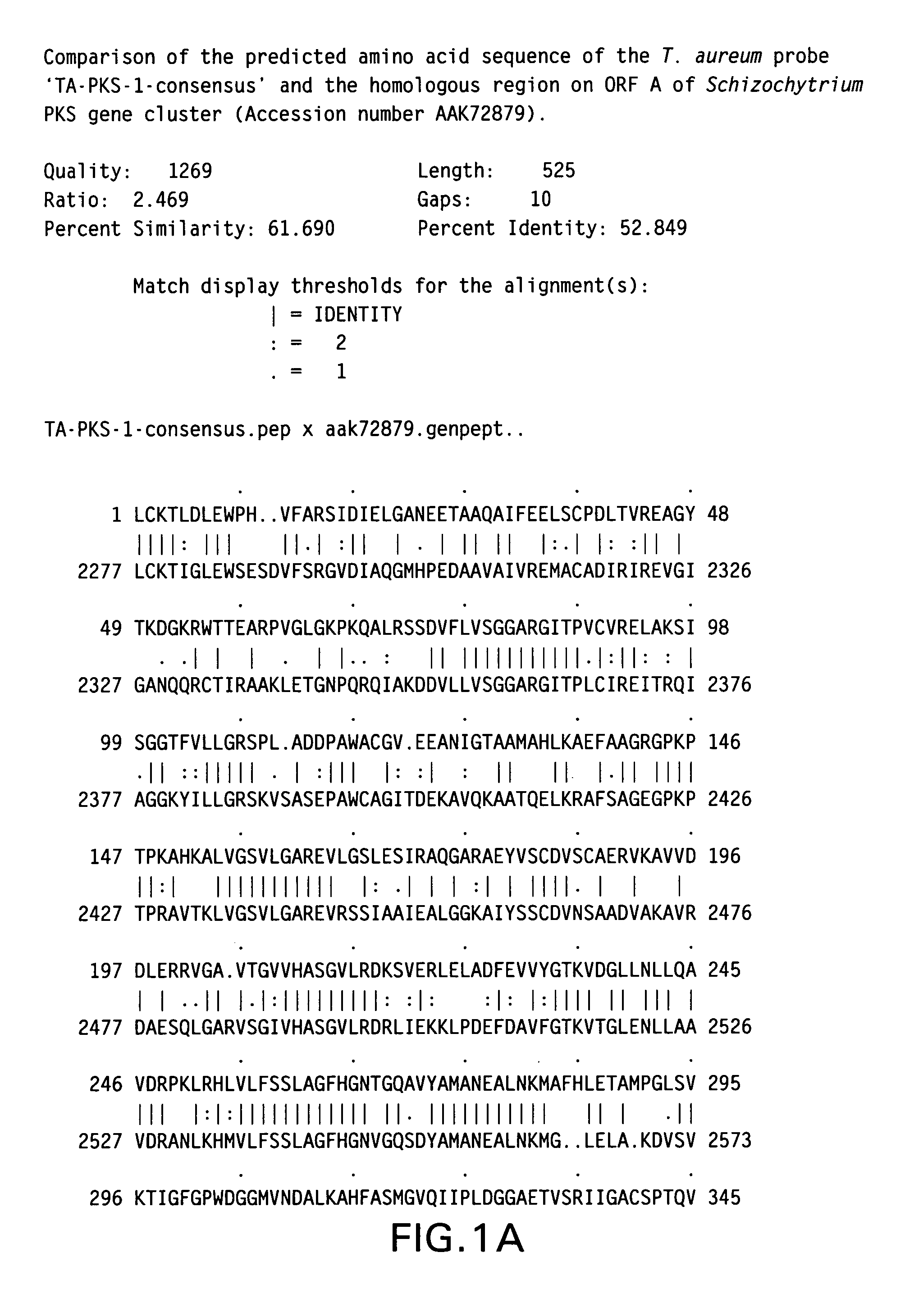Genes involved in polyketide synthase pathways and uses thereof
a polyketide synthase and polyketide technology, applied in the direction of enzymology, organic chemistry, transferases, etc., can solve the problems of inflammatory and cardiovascular complications, -3 pufas such as fish oil are not economical or renewable, and are not suitable for commercial needs
- Summary
- Abstract
- Description
- Claims
- Application Information
AI Technical Summary
Benefits of technology
Problems solved by technology
Method used
Image
Examples
example i
Construction of BAC Library from Thraustochytrium aureum (ATCC 34304)
[0108]Thraustochytrium aureum (ATCC 34304) is an organism that produces copious amounts of polyunsaturated fatty acids (PUFAs) such as DHA which can amount to ˜30%–40% of its total fatty acid, a major portion of which appears in its triacylglyceride fraction. This organism belongs to the Thraustochytrid family of marine organisms, which include organisms like Schizochytrium, Ulkenia, Aplanochytrium etc, many of which make DHA. Recent studies with Schizochytrium have revealed the presence of polyketide synthase (PKS) gene clusters that are involved in DHA biosynthesis (Metz et al., Science (2001) 293:290–293; U.S. Pat. No. 6,566,583), similar to the PKS gene clusters seen in the EPA- and DHA-producing prokaryotes like Shewanella (Yazawa, K., (1996) Lipids 31 Suppl.:S297–300) and Vibrio (Morita et al., (1999) Biotechn. Lett. 21:641–646). Since Thraustochytrium aureum and Schizochytrium belong to the same family, it w...
example ii
Identification of PKS Gene Probes from Thraustochytrium aureum (ATCC 34304) for Colony Hybridization
[0113]Some of the PKS probes used for the screening of the BAC libraries were identified by random sequencing of a cDNA library constructed from T. aureum. The cDNA library was constructed as follows: T. aureum (ATCC 34304) cells were grown in BY+ Media (#790, Difco, Detroit, Mich.) at room temperature for 4 days, in the presence of light, and with constant agitation (250 rpm) to obtain the maximum biomass. These cells were harvested by centrifugation at 5000 rpm for 10 min. and rinsed in ice-cold RNase-free water. These cells were then lysed in a French Press at 10,000 psi, and the lysed cells were directly collected into TE buffered phenol. Proteins from the cell lysate were removed by repeated phenol: chloroform (1:1 v / v) extraction, followed by a chloroform extraction. The nucleic acids from the aqueous phase were precipitated at −70° C. for 30 minutes using 0.3M (final concentrat...
example iii
Identification of PUFA-PKS-Related Sequences from Thraustochytrium aureum
[0123]For screening of the T. aureum BAC library with the various probes described above, the library was plated on selective media as described in Example II, and white colonies were replica plated onto Hybond-N+ nylon membranes (Amersham Pharmacia, Piscataway, N.J.). The colonies were then lysed by incubation in 10% SDS for 5 min, denatured in [0.5N NaOH, 1.5M NaCl] buffer for 5 min, and neutralized in a solution containing [1.5M NaCl, 0.5M Tris.Cl (pH 7.4)] for 5 min. The membranes were then incubated in 2×SSC buffer with 0.1% SDS for 5 min, followed by treatment with 0.4 N NaOH for 20 min. Finally the filters were washed once in 2×SSC buffer for 20 min, followed by a wash in 5×SSC buffer for 5 min., and were finally dried at room temperature.
[0124]For hybridization, the membranes were prehybridized at 65° C. for 10 h in a buffer solution containing [1% BSA, 1 mM etylenediaminetetraacedic acid (EDTA)(pH 8.0...
PUM
| Property | Measurement | Unit |
|---|---|---|
| Fraction | aaaaa | aaaaa |
| Fraction | aaaaa | aaaaa |
| Fraction | aaaaa | aaaaa |
Abstract
Description
Claims
Application Information
 Login to View More
Login to View More - R&D
- Intellectual Property
- Life Sciences
- Materials
- Tech Scout
- Unparalleled Data Quality
- Higher Quality Content
- 60% Fewer Hallucinations
Browse by: Latest US Patents, China's latest patents, Technical Efficacy Thesaurus, Application Domain, Technology Topic, Popular Technical Reports.
© 2025 PatSnap. All rights reserved.Legal|Privacy policy|Modern Slavery Act Transparency Statement|Sitemap|About US| Contact US: help@patsnap.com



